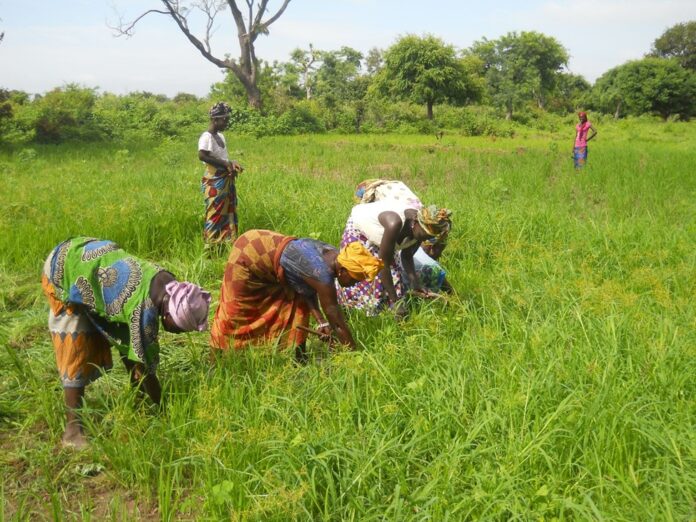Abdoulai G. Dibba
The importation of rice is rising year- in and year- out while the national production level is declining annually despite donor intervention in the production of the staple.
Rice is the major staple for Gambians with a per capita consumption of 117kg.
The national requirements for rice in 2019 was 398,364 metric tons (MT) while the national production was estimated at only 22,706 metric tons (MT) or only 5.7 percent of the country’s needs.
This low production in rice indicates vividly that the country is far from being self-sufficient in rice production and has to rely on imports and aid to cover the over 90 percent deficit.
Despite the fact that rice is cultivated in the upland, lowland and hydromorphic soils, mangrove swamps and in the tidal or pump irrigated lowland in all agro-ecologies, production and area cultivation has been declining.
For example, while area under cultivation in 2000/2001 cropping season was 16, 700 hectares, production was 34, 100 metric tons.
However, in 2006/2007 cropping season, area under cultivation declined to 15, 200 hectares and production as well declined to 15, 800 metric tons in the same year.
What is gratifying to note is the fact that while area under cultivation increases, production declined miserably.
For example, while area under cultivation in 2009/2010 was 32, 600 hectares, production was 49, 900 metric tons; while in 2014/2015 cropping, area under cultivation was 66, 280 hectares twice that of 2009/2010 cropping season, production decline to 46, 670 metric tons compare to 2009/2010 cropping season.
This rise in area under cultivation characterised by declining production, raise the alarming bell of some form of constraints in the rice production sector.
This is precisely the reason why Lamin MS Jobe, the former Director of Research at the National Agricultural Research Institute was approached to authenticate whether or not there are constraints in the sector.
According to him, the Gambia possesses a range of suitable ecologies for rice production, namely rain fed upland, rain fed lowland, mangrove swamps and the irrigated swamps.
However, he said the factors responsible for the low local rice production and declining land areas for cultivation are numerous and diverse and the reasons may vary from one ecology to another.
The Upland ecology, he went on to say, has huge potential for increasing rice production in this country, area under cultivation for this ecology in 2006 was about 10,000 ha; 47,500 ha in 2011 and rose to 50,000 ha in 2013 (NRDS.2014). The former NARI Director of Research asserted that this shows the importance that this ecology has in the development of rice production in this country.
Unfortunately, he said this ecology is characterized by low soil fertility, huge weed control requirement, and socioeconomic constraints such as encroachment by human settlements especially in the Kombos and the rural urban areas and stray animal pests.
With regard to the lowland ecology (including irrigated swamps) Director Jobe said there is still huge potential for expansion in this ecology; there has been a lot of investment in this ecology.
Jobe pointed out that there are much lowland ecology that has never been exploited and many sites that have been abandoned due to the many constraints in the ecology.
Major among the constraints in this ecology is land development. “Difficulties and delays in land preparation result in serious delays in the required cultural operations in this ecology,” Director Jobe stated.
This in turn he went on to say, impacts negatively on yields and the turnaround time that will allow an effective double cropping.
“As for the mangrove swamps, this ecology was the food basket of the country when farmers in this ecology will evacuate the old produce to make room for the new produce but unfortunately, this is the most hostile and difficult ecology,” Jobe posited.
He noted that soils in this ecology are generally very fertile but access is generally very difficult, land development difficult, in some parts of the country hippos are a major pest and the youth rural urban migration from villages with this type of ecology means that the women and old left in the villages had to abandon most of this ecology today.
He said evidence of the above can be seen in the North Bank Bambatenda Farafenni road where all the fields are taken over by mangrove plants, Sarrakunda to Bambally mangrove swamps all taken over by aquatic weeds and mangrove.
What needs to be done to address the rice problem? According to the Former NARI Director of Research, they have seen a huge potential for the upland rice cultivation but today the area under cultivation for this ecology will half of what it was in 2014.
Therefore, he said that to address the declining the area under cultivation and low production, first of all, there is need to restructure and empower the farmer organisations in this country.
“Local farmer organizations must be strong and vibrant; there needs to be more involvement of farmer organizations in policy making especially in pricing of their produce and other agricultural decision making processes,” he said.
While constraints confront the rice sector, the donors has been intervening in the production and productivity of rice.
Donor Interventions
For example, a project entitle Lowland Agricultural Development Programme which was implemented from 1997 to 2004 to the tune of US$11.66 million; has the objective of sustainably increase rice production through improved access and water control.
In the same vein, the Irrigated Integrated Rice Development Project which was at the tune of US$3.728 million; to be implemented from 2001 to 2005, was to increased rice production and productivity.
But, the high donor intervention in the rice production sector has not correspond to increased production and reduced importation.
The Participatory Integrated Watershed Management Project was funded at the tune of US$12.085 million from 2005 to 2010; and its objectives were to increase land productivity and reduce soil erosion on a sustainable basis.
It is apt to state that while these three projects were being implemented within the timeframe of 2001 to 2010, rice production in 2001 when the first project started was 34,100 metric tons while imports was 48, 866 metric tons equivalent to D130, 812, 000 (one hundred and thirty million, eight hundred and twelve thousand dalasi) and rice aid received was 2, 600 metric tons.
However, in 2010 when all the three projects phased out, total rice production was 49,900 metric tons while import was 88, 214 metric tons equivalent to D670, 700, 784 (six hundred and seventy million, seven hundred thousand, seven hundred and eighty-four dalasi).
The National Agricultural Land and Water Management Development Project (Nema) was officially launched on 26-28 February, 2013.
The Project was in response to The Gambia government’s request to IFAD for a substantial project that will contribute to the implementation of The Gambia National Agricultural Investment Plan (2011-2015), particularly programmes 1 and 3 which are:-
Improve agricultural land and water management; and develop agricultural chains and market promotion in an effort to alleviate food insecurity.
The geographic coverage of the project is defined as all six agricultural regional directorates along the River Gambia, essentially the whole rural sector.
The project was to be implemented in seven years from 2013 to 2019 inclusive at a total project costs of 64.9 million US dollars (or D3064 million).
The project was funded principally by IFAD with two grants totalling 34.4 million US dollars (53.0% of the estimated project cost of 64.94 million US dollars), a concessional loan of 15.0 million US dollars (23.1%) from Islamic Development Bank (IsDB), and further financial contributions from one or more other development partners of 11.8 million US dollars (18.1%), Gambia Government contribution of 2.6 million US dollars (4.0%).
Looking at rice production and importation during the timeframe of the project, one would realise that in 2013/2014 cropping season when the project was launched, area under cultivation was 66, 300 hectares and total production was 69, 700 metric tons, while imports stood at 130,226 metric tons equivalent to D1, 134,640,365(One billion, one hundred and thirty-four million, six hundred and forty thousand, three hundred and sixty-five Dalasi).
In the same vein, while the national requirement of rice in 2019, (the year that the NEMA project was to phase out) catapulted to 398,364 metric tons, the national production was projected at 22,706 metric tons.
This is precisely the reason why the value for imported rice in 2019 stood at D2, 562,543,000(Two billion, five hundred and sixty-two million, five hundred and forty-three thousand Dalasi).
Last year, a new project entitle ‘Rice Value Chain Transformation Project’ (RVCTP) , a 7million USD project was launched and is expected to phase out in 2024; it is a 5 year project.
According to Lamin Fatajo, the Project Director, the primary objective of the project is to intensify production in order to reduce the importation of rice in the country which correlates with the long term food self- sufficiency drive of the Ministry of Agriculture.
Looking at the 2020 budget, one can discover that an amount of D5, 000, 000(five million Dalasi was approved for this project from the Government Local Fund (GLF) and D203, 092, 977(Two hundred and three million, ninety-two thousand, nine hundred and ninety-nine Dalasi) from the Africa Development Bank (ADB).
In the 2021 budget, one could discover an estimated amount of D7, 000,000 (Seven million Dalasi from the GLF, D101, 000,000 (One hundred and one million Dalasi) from the ADB and D6, 000,000 (Six million Dalasi) from the Islamic Development Bank (IDB).
According to Lamin MS Jobe, the expansion of rice production in the Gambia will be achieved through rehabilitation of abandoned areas, land development and irrigation infrastructure development while intensification of production will additionally be construction of access roads and the cultivation of short-duration rice varieties.
“Most of the decisions to intervene in agriculture are taken from the top, sometimes even dictated by the donor and many a times the involvement of the grass root beneficiaries is minimal,” Former NARI Director of Research concluded.


















